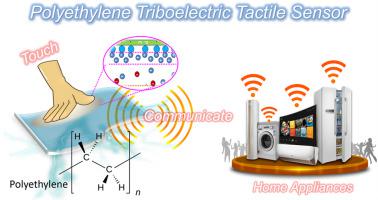Sustainable Materials and Technologies ( IF 8.6 ) Pub Date : 2020-12-11 , DOI: 10.1016/j.susmat.2020.e00239 Thitirat Charoonsuk , Rangson Muanghlua , Saichon Sriphan , Satana Pongampai , Naratip Vittayakorn

|
To promote the sustainable development of single-used polyethylene (PE) commodity plastic for long-lasting use in advanced electronic devices, this work presented a successful strategy for converting PE plastic bags, which usually end up in landfills, into specifically flexible and transparent triboelectric tactile sensors (TES). In order to enhance the electrical output to meet the practical application, liquid phase electrolytes (LPEs) were introduced between double sides of thin PE layers. LPE utilization had significant influence on the output signal, resulting in an effective response to physical contact with the human hand. The effect of LPE types, i.e., acids, salts and solvent as well as concentration, on output signal was studied and clarified. The scientific working mechanism for PE/LPE TES was described based on the coupling behavior between contact electrification, electrostatic induction and ion conduction within the electric double layer. The PE/LPE TES showed the optimized signal response of Voc ~1.6 V, Isc ~673 nA and 450 W/cm2, enabled by tunable LPE types and concentrations, thus providing a hundred times more than that of pristine PE. By integrating PE/LPE TES with a signal-processing circuit, wireless application of the complete tactile sensing system has been developed further to make contact with and control home appliances such as a light bulb and an electric fan. Its flexibility and transparency has great potential adaptation for the active tactile system that can be attached to different wearable devices, textiles, or home interior decoration. This work demonstrates a facile strategy for promoting PE plastic as a high value-added electronic product that has the potential to pave the way for development in large-scale industry, and help in treating used plastic in the future. It also has the opportunity to obtain a tactile sensor that is affordable and cost-effective in making a valuable contribution in the global sensor market, thus ensuring sustainable development in both social and economic terms.
中文翻译:

通过增强液相液体电解质的传感性能,将商品热塑性聚乙烯(PE)用于柔性和透明的摩擦电触觉传感器
为了促进在高级电子设备中长期使用的一次性使用的聚乙烯(PE)商品塑料的可持续发展,这项工作提出了一种成功的策略,可以将通常装在垃圾填埋场中的PE塑料袋转化为特别柔软且透明的摩擦电触觉传感器(TES)。为了提高电输出以满足实际应用,在薄PE层的两面之间引入了液相电解质(LPE)。LPE的使用对输出信号有重大影响,从而导致对与人手物理接触的有效响应。LPE类型的影响,即研究并阐明了酸,盐和溶剂以及浓度对输出信号的影响。基于双电层内接触带电,静电感应和离子传导之间的耦合行为,描述了PE / LPE TES的科学工作机制。该PE / LPE TES显示的优化信号响应V OC〜1.6 V,我SC〜673 nA和450瓦/厘米2通过可调的LPE类型和浓度实现,因此比原始PE的含量高一百倍。通过将PE / LPE TES与信号处理电路集成在一起,完整的触觉传感系统的无线应用得到了进一步发展,可以与灯泡和电风扇等家用电器进行接触和控制。它的灵活性和透明度对于主动触觉系统具有巨大的潜在适应性,该触觉系统可以连接到不同的可穿戴设备,纺织品或家庭室内装饰。这项工作展示了一种将PE塑料作为高附加值电子产品推广的简便策略,该策略有可能为大规模工业的发展铺平道路,并在将来帮助处理废旧塑料。











































 京公网安备 11010802027423号
京公网安备 11010802027423号